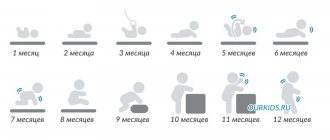Changes at the physiological level
By the fourth month of life, the baby completely adapts to the environment, and his body begins the next stage of its development - a serious psycho-emotional and physical restructuring. The transformation affects all organs and systems of a small person: physiology changes, psychomotor functions actively develop, the first emotions appear, unconditioned reflexes gradually disappear, and the most important skills come to replace them.
This period in a baby’s life is one of the most important and responsible, since it is at 4 months that significant physiological changes occur in the body, which will serve as the basis for the future development and health of the child. Therefore, it is so important not to miss this serious moment and, in case of a possible deviation, to take action in time.
Physiological characteristics of a baby who has passed the four-month mark:
- The organs of vision are already quite well developed: a child at 4 months can perceive and distinguish shades and colors, as well as consciously focus his gaze on objects and faces. Visual acuity improves, and the baby gains the ability to see well not only near, but also at a distance. At this age, the color of the eyes changes to a constant one, and the visual muscles become stronger and, as a result, the slight strabismus characteristic of many newborns disappears.
- The lacrimal glands begin to work, and crying is already accompanied not only by screaming, but also by tears.
- The auditory organs are practically formed: the baby turns his head towards the sound source, shows a reaction to addressing it from a distance of 2.5 m, listens carefully to speech and distinguishes intonations. Reacts to sharp sounds, as well as slow or rhythmic music.
- The functioning of the digestive system is improved: gastric enzymes are produced in the required quantities, breaking down and digesting food. This has a positive effect on all functions of the gastrointestinal tract: colic and intestinal spasms stop, the frequency and consistency of stool returns to normal, and appetite improves. As a result, the child becomes calmer and more relaxed, sleeps better and wakes up much less often at night.
- Many unconditioned reflexes characteristic of newborns in the first weeks of life are practically no longer observed by four months. So, by this age the search, proboscis, protective and Babkin reflexes should completely disappear. If the latter are still present, it is necessary to show the child to a neurologist.
Approximate daily routine
A child's daily routine changes slightly at 4 months. The main difference is the reduction in sleep norms from 18 to 16 hours a day .
This increases the intervals of wakefulness, which now last about an hour and a half.
Night sleep lasts up to 10 hours, but during the day the baby sleeps three times for two hours.
An approximate crumb mode looks like this:
- 06:00–8:00 - rise and first feeding. During this period, all necessary hygiene procedures are carried out - washing, changing a diaper, air baths, etc.
- 08:00–10:00 - sleep.
- 10:00–12:00 – feeding, massage, games and communication.
- 12:00–14:00 – walk and sleep.
- 14:00–16:00 – feeding and active games.
- 16:00–18:00 – walk, sleep.
- 18:00–21:00 – feeding, educational games and bathing the baby.
- 21:00-00:00 - night sleep.
- 00:00–06:00 – feeding and night sleep.
It is important to understand that each child is individual, which means that the daily routine should be formed solely based on the characteristics of the baby.
Height and weight indicators
Physical indicators help to assess the correct development of a child. To do this, the baby undergoes monthly checks to ensure compliance with age standards. Thus, a strong deviation from generally accepted parameters in the direction of decrease or, conversely, increase can be a sign of a lack (or excess) of one or another useful substance, and can also be a symptom of a serious disease of the internal organs.
Boys are slightly ahead of girls in some areas because they tend to be born larger, but the monthly weight and height gains are approximately the same for both.
Table of physical development at four months, according to Russian pediatricians:
| Index | Bottom line | Upper limit |
| Boys' weight, kg | 5,5 | 7,6 |
| Girls' weight, kg | 5,4 | 7,0 |
| Boys' height, cm | 58,7 | 64,5 |
| Girls' height, cm | 58,4 | 64,0 |
| Boys' head circumference, cm | 40,2 | 43,6 |
| Head circumference of girls, cm | 39,1 | 42,2 |
| Boys chest circumference, cm | 38,6 | 44,6 |
| Girls chest circumference, cm | 38,9 | 43,0 |
According to the World Health Organization (WHO), the standards look like this:
| Index | Bottom line | Upper limit |
| Boys' weight, kg | 5,6 | 8,7 |
| Girls' weight, kg | 5,0 | 8,2 |
| Boys' height, cm | 59,7 | 68,0 |
| Girls' height, cm | 57,8 | 66,4 |
| Boys' head circumference, cm | 39,2 | 44,0 |
| Head circumference of girls, cm | 38,1 | 43,1 |
Babies born prematurely can lag far behind their peers in terms of weight, height and other values, the same applies to children who, for hereditary reasons, were born excessively large.
Pediatricians consider this situation to be quite natural and advise parents not to worry too much, but also not to leave the problem unattended: in both cases, it is recommended to first show the child to a specialized specialist who will help adjust the infant’s diet.
Increase
At the age of up to one year, the baby grows very quickly, delighting parents with changes in his appearance.
The average growth rates for the 4th month were calculated, which are considered the norm.
- Weight. By the time a child reaches 5 months, he gains up to 400-560 g, which is associated with his low physical activity. The norm is a weekly increase of 120 g in boys and 110-115 g in girls.
- Height. In a month, the child will stretch a little: a boy - by 2 cm, a girl - by 1.9 cm.
The rate of development of children is individual, so pediatricians recommend drawing up your own schedule, in which every month you record how many centimeters and grams the baby has grown. You can use this formula for calculation:
baby's weight after birth + 750 g x 4.
4 is the number of months, 750 grams is the norm that a baby should gain monthly at the age of 1-3 months.
Experts note that infants grow faster than their peers who are switched to artificial feeding.
Mental and emotional development
Important changes also occur at the child’s psycho-emotional level. The baby is interested in the surrounding space with pleasure, carefully studies his body and strives for contact with loved ones. At 4 months, the baby’s nervous system is actively developing. This manifests itself in the following reactions:
- The child begins to experience and express various emotions. It can be either intense joy or surprise, or dissatisfaction, excitement and irritation. Such manifestations at first are only short-term in nature and very quickly replace each other.
- The first speech functions appear, expressed in loud laughter and screaming. The child begins to pronounce short syllables, and also actively hums and coos.
- The baby shows his interest: he joyfully reaches for the toy, turns his head towards a random sound, and also looks at his arms and legs with curiosity for a long time.
- The ability to distinguish the faces of loved ones and strangers is a very important sign of the normal development of a child at 4 months: girls can recognize their mother even in a photograph, while boys are a little behind in psycho-emotional development, however, at this age they are already good at distinguishing mom or dad from someone else’s person. In the first case, the baby begins to joyfully twitch his legs, smile and pull his arms. When seeing a stranger, the child, on the contrary, tenses up, tries to turn away or begins to cry loudly.
- Learning your name also indicates the full development of a baby who has reached the age of four months.
How much should a baby weigh at 4 months?
For every mother, the health of the baby is the main value, so she begins to worry if the weight indicators do not fit into the data from the table, if the child is smaller or larger than the average - from 5.6 to 7.8 kg. There may be several reasons.
- Genetics. So, if mom or dad are large, then the child’s high weight is understandable.
- Nutrition specifics. When breastfed, children develop much faster, so a slight deviation from the norm in “artificial” babies is normal.
- Activity. The more active the baby, the slower he gains weight.
Standards, of course, are very useful and help determine whether everything is okay with the baby, but you need to focus on its specific indicators, primarily on weight after birth and growth in the first three months.
If the baby is underweight by more than 1 kg, is regularly capricious, and eats poorly, then you should show him to the pediatrician, as this may be a sign of a gastrointestinal tract disease. Also, the reasons for poor weight gain include an error in choosing a formula if the child is not fed breast milk: perhaps the baby does not receive the number of calories he needs.
But if the lag is smaller, and the baby is active and cheerful, then, most likely, these are the individual characteristics of his development and there is no reason for concern.
The same applies to excess weight: if a child weighs more than 1 kg more than normal, and at birth was not large in size, this may be an alarming sign of obesity, which, in turn, can lead to pathologies of internal organs and diabetes mellitus.
Physical skills
The child becomes much stronger than before, and his movements become quite conscious. Some children at this age even try to sit on their buttocks, but in no case should you artificially sit the child up, resting him on pillows, since such impatience of parents can lead to injury to the baby’s fragile spine.
What should a 4 month old baby be able to do:
- Roll over from your back to your stomach and then back;
- Try to pull yourself up while holding onto the bar or an adult’s hand;
- When feeding, hold the mother's bottle or breast with your hands;
- Lying on your stomach, raise your buttocks and try to push your legs off the surface;
- Consciously take the toy and hold it in your hand for a while;
- While lying on your back, raise your head along with your shoulder body;
- Hold your head well;
- Raise your body, resting on your palms;
Growth: causes and consequences of deviations from the norm
The baby's growth retardation should not worry the mother if it does not exceed 10% of the average value. Of course, there may be exceptions. So, if all family members are short, then it is not surprising that the child will also be miniature. There are situations where a baby was far behind until the age of 8-9 months, but then quickly caught up with his peers.
Causes of stunting include poor nutrition, recent illnesses, and stressful situations. But sometimes you should pay attention to your health status. Thus, a small growth rate may be due to heart defects, anemia, bronchial asthma, disorders in the endocrine system, and diabetes. Sometimes developmental delays can be caused by taking certain medications. And exceeding the growth rate is most often associated with hormonal problems.
Whatever the reason, it is important to detect and eliminate it in a timely manner: change your diet, undergo a full medical examination.
At 4 months, it is very important to pay due attention to the height and weight of babies, to understand whether they correspond to standard averages. Of course, a minor deviation is not a reason to panic, but a careful attitude will allow you to detect the problem in a timely manner and do everything to solve it.
Nutrition for a four month old baby
According to all the recommendations of modern pediatricians, a child at the age of four months should receive only breast milk. If for some reason the mother cannot keep the baby on natural feeding, the latter is replaced with high-quality milk formulas and complementary foods are introduced in the form of a small amount of vegetable puree or porridge.
At 4-5 months, the baby is usually transferred to 5 feedings a day. The last intake of milk should approximately occur at 20-21 hours, after which a healthy and well-fed baby usually sleeps for about 10 hours. However, not all children of this age are able to go without food for so long and still wake up at night for their usual meals. You should not ignore such requests from your child, but instead of milk, it is better to give him some baby tea or diluted natural juice. Gradually, the baby will get used to the new diet and sleep peacefully throughout the night.
The feeding schedule for a formula-fed baby should be more precise and strict, since not even the most expensive and high-quality formula can replace natural mother’s milk.
An artificial baby should eat at least 6 times a day with intervals between feedings of 3.5 hours. The daily norm of the mixture is determined in this way: the child’s weight (in grams) is divided by 7. The resulting number is the total volume needed for the day. Next, this amount is evenly distributed into 6 servings. On average, it turns out that a baby should consume approximately 150-170 ml of the adapted formula per feeding. It is recommended to introduce complementary foods very carefully after consultation with a pediatrician. It is usually better to start with one small spoon per day, gradually increasing the daily portion to 100 g.
When a child does not gain the desired weight
In the first days after birth, while still in the maternity hospital, the baby experiences weight loss. A loss of up to 10% of body weight at birth is considered normal. This is due to the stress experienced during childbirth, the lack of breast milk in the first days of life (lactation begins approximately on the 3rd day after birth), as well as the release of meconium. After discharge, on days 4-5, the weight should increase. The increase should be 600-800 g per month. At this age, breastfeeding should be done without introducing complementary foods.
How long should a 7 month old baby sleep?
There is no need to sound the alarm or panic if the child’s weight does not fit into the norm according to the proposed tables. Before treating a child, it is necessary to evaluate the following factors that affect the child's growth:
- heredity;
- birth weight;
- mother's nutrition during pregnancy;
- the physical condition of the mother during pregnancy;
- dietary habits and lifestyle;
- nationality and place of residence.
At 4 months, the first baby teeth may begin to grow, but the baby becomes capricious and loses his appetite. If your gums are swollen and your finger is constantly being pulled into your mouth, you can alleviate the suffering - apply a special gel to the reddened areas in the mouth, rub in the gel with a cooling and analgesic effect. It is also necessary to help scratch the gums; for this you can purchase a special silicone brush that fits on your finger, and regularly “clean” your teeth in this way. There are special teethers on sale - silicone toys filled with water. They need to be pre-cooled in the refrigerator and given to the baby; he will be happy to “middle” with them.
Important! At this age, do not give dried bread, crackers, apples, bananas and other foods that can be bitten off. A child can choke on a piece, even without teeth.
Underweight
The reasons for weight loss may be the following:
- a breastfed child has a lack of breast milk;
- in a bottle-fed child - the wrong choice of formula, low calorie content, lack of proteins and fats in it;
- if you eat enough, but your weight does not increase, you need to get tested for worm eggs;
- a disorder in the functioning of the stomach in which food is not digested or is only partially digested.
Important! If a child cries often, greedily sucks at the breast or bottle, the weight gain over the entire 4 months was less than 2 kg, and he has dry skin, there is reason to assume that problems have arisen with the child’s development. First of all, you need to contact a pediatrician who will carry out a control weighing and accurately determine the weight gain.
If the child is not gaining weight due to lack of food, and serious diseases are excluded, then the following rules must be followed:
- Apply to the breast more often, reduce the intervals between feedings. More milk will be produced, and the baby will be full.
- Do not give the second breast until the milk in the first breast runs out, since the most high-calorie milk is produced at the end.
- If breast milk is still not enough, supplement with an adapted infant formula.
- Make sure your baby is latching onto the nipple or bottle nipple correctly. Perhaps the reason is a short frenulum under the tongue.
- As the latest way to gain weight, after permission from the pediatrician, you can introduce early complementary foods. Start with gluten-free cereals: buckwheat and rice.
Daily routine and daily procedures
In addition to proper development and nutrition, a child at 4 months must learn to adhere to a certain regime: clearly distinguish day from night, as well as sleep, be awake and walk at approximately the same time. Such a schedule does not have to be perfectly time-accurate, but it is still necessary to adhere to its sequence. In addition to sleeping and feeding, the daily routine of a four-month-old baby must include:
- Walks in the open air. They should be regular regardless of the weather. The only difference is their duration: in the warm season, the baby needs to be outside for at least 3–4 hours, while in the cold season, the time spent outdoors should be reduced to 1–2 hours. Walking is important for a four-month-old baby not only to strengthen his immunity, but also to explore the surrounding space.
- Developmental activities. A baby at this age really needs communication and games, so you should talk to the child as often as possible, read him short nursery rhymes and sing songs. It is not recommended to hang too many bright, but monotonous rattles over the crib - it is much more useful if such toys are different in shape, color and sounds. Children at this age love to watch the flight of soap bubbles, but you need to be careful that the soap from such balls does not get into the child’s face.
- Water procedures. Four-month-old babies, as a rule, respond well to bathing, so such procedures should be done daily. For baths, it is advisable to use herbal infusions, pine extracts or sea salt. However, before using these supplements, you should consult your local pediatrician.
- Gymnastics and massage are the basis for the physical development of the baby. Gymnastics classes are best done in the morning, when the child is most active. It is better to do a massage after taking water procedures before going to bed. In the store you can purchase special baby massage oils that have a calming and relaxing effect on the nervous system, helping the baby to better tune in for a night's rest.
Development at four months does not always clearly correspond to the described standards, since there are a number of reasons why a baby may lag behind his peers in certain indicators.
And if the doctor does not see any serious abnormalities in the mental or physical functioning of the child’s body, there is no need to panic. It is much more important to remember that even an infant is a small person with his own individual qualities and temperament.
Physiological development: weight, height
By 4 months, most babies have reached the significant physical milestone of doubling their birth weight. On average, the baby will weigh at least 6-7 kg, and sometimes more. We remember that every baby is different from the next. For example, if your baby was born premature, it may take him a little longer to gain weight by the 4-month mark.
Table of development norms
Common problems at this age and how to solve them
The most common problems in children at 4 months:
- Teeth are being cut. The child becomes extremely restless, often capricious and does not allow his gums to be examined. You can help your baby by preparing a special toy for him and a local anesthetic that can temporarily relieve irritation.
- Bad dream. The problem usually concerns daytime sleep and can be caused by overexcitement, dry air, inappropriate temperature, etc. Ventilate the room and play calm games with your baby or read a fairy tale to calm him down.
- Feeding problems. The baby bites his mother's breast, assessing her reaction. The problem is solved by silicone nipple covers, sold in pharmacies.
- The baby is often distracted during feeding. You can only wait out this period; after looking around, the baby will return to eating.
Contact your doctor immediately if you notice the following signs:
- Inability to hold head up.
- Lying on his stomach, the child does not try to lift his body.
- Doesn't turn over.
- Doesn't look for the source of sounds.
- Doesn't try to grab toys.
- There are reflexes that should have gone away by this age.
Child development
At 4 months of life, the brain begins to develop more actively. The digestive system is stabilized, which is reflected in the virtual disappearance of intestinal colic in the child. The proportions of the baby's body become more harmonious - the girth of the chest is almost equal to the girth of the head, the legs are straightened and lengthened.
The child's nails and hair begin to actively grow. Long fingernails can cause microtrauma and scratching, so they should be trimmed regularly.
At this age, the baby's eye color changes. At birth, a newborn's eyes have a light blue tint. This is explained by the absence of melanin in the iris. As the baby develops, the body produces and accumulates melanin, as a result of which the color of the eyes begins to change. The amount of melanin in the body is determined by heredity.











